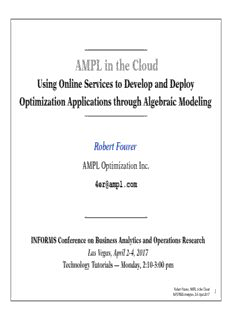
AMPL in the Cloud PDF
Preview AMPL in the Cloud
AMPL in the Cloud Using Online Services to Develop and Deploy Optimization Applications through Algebraic Modeling Robert Fourer AMPL Optimization Inc. [email protected] INFORMS Conference on Business Analytics and Operations Research Las Vegas, April 2-4, 2017 Technology Tutorials — Monday, 2:10-3:00 pm Robert Fourer, AMPL in the Cloud 1 INFORMS Analytics, 2-4 April 2017 The Optimization Modeling Cycle Steps Communicate with problem owner Build model Prepare data Generate optimization problem Submit problem to solver Gurobi, Knitro, CPLEX, Xpress, CONOPT, MINOS, . . . Report & analyze results Repeat until you get it right! Goals for optimization software Do this quickly and reliably Get results before client loses interest Deploy for application Robert Fourer, AMPL in the Cloud 4 INFORMS Analytics, 2-4 April 2017 Optimization Modeling Languages Two forms of an optimization problem Modeler’s form Mathematical description, easy for people to work with Solver’s form Explicit data structure, easy for solvers to compute with Idea of a modeling language A computer-readable modeler’s form You write optimization problems in a modeling language Computers translate to algorithm’s form for solution Advantages of a modeling language Faster modeling cycles More reliable modeling More maintainable applications Robert Fourer, AMPL in the Cloud 5 INFORMS Analytics, 2-4 April 2017 Algebraic Modeling Languages Formulation concept Define data in terms of sets & parameters Analogous to database keys & records Define decision variables Minimize or maximize a function of decision variables Subject to equations or inequalities that constrain the values of the variables Advantages Familiar Powerful Proven Robert Fourer, AMPL in the Cloud 6 INFORMS Analytics, 2-4 April 2017 Features Algebraic modeling language Built specially for optimization Designed to support many solvers Design goals Powerful, general expressions Natural, easy-to-learn modeling principles Efficient processing that scales well with problem size 3 ways to use . . . Robert Fourer, AMPL in the Cloud 8 INFORMS Analytics, 2-4 April 2017 3 Ways to Use AMPL Command language Browse results & debug model interactively Make changes and re-run Scripting language Bring the programmer to the modeling language Programming interface (API) Bring the modeling language to the programmer Robert Fourer, AMPL in the Cloud 9 INFORMS Analytics, 2-4 April 2017 Example: Roll Cutting Motivation Fill orders for rolls of various widths by cutting raw rolls of one (large) fixed width using a variety of cutting patterns Optimization model Decision variables number of raw rolls to cut according to each pattern Objective minimize number of raw rolls used Constraints meet demands for each ordered width Robert Fourer, AMPL in the Cloud 10 INFORMS Analytics, 2-4 April 2017 Roll cutting Mathematical Formulation Given (cid:1849) set of ordered widths (cid:1866) number of patterns considered and (cid:1853) occurrences of width (cid:1861) in pattern (cid:1862), (cid:3036)(cid:3037) for each (cid:1861) ∈ (cid:1849) and (cid:1862) (cid:3404) 1, . . . , (cid:1866) (cid:1854) orders for width (cid:1861), for each (cid:1861) ∈ (cid:1849) (cid:3036) Robert Fourer, AMPL in the Cloud 11 INFORMS Analytics, 2-4 April 2017 Roll cutting Mathematical Formulation (cont’d) Determine (cid:1850) number of rolls to cut using pattern (cid:1862), (cid:1862) for each (cid:1862) (cid:3404) 1, . . . , (cid:1866) to minimize (cid:3041) ∑ (cid:1850) (cid:3037)(cid:2880)(cid:2869) (cid:3037) total number of rolls cut subject to (cid:3041) ∑ (cid:1853) (cid:1850) (cid:3410) (cid:1854) , for all (cid:1861) ∈ (cid:1849) (cid:3037)(cid:2880)(cid:2869) (cid:3036)(cid:3037) (cid:3037) (cid:3036) number of rolls of width (cid:1861) cut must be at least the number ordered Robert Fourer, AMPL in the Cloud 12 INFORMS Analytics, 2-4 April 2017 Roll Cutting AMPL Formulation Symbolic model set WIDTHS; param orders {WIDTHS} > 0; param nPAT integer >= 0; param nbr {WIDTHS,1..nPAT} integer >= 0; var Cut {1..nPAT} integer >= 0; minimize Number: sum {j in 1..nPAT} Cut[j]; subj to Fulfill {i in WIDTHS}: sum {j in 1..nPAT} nbr[i,j] * Cut[j] >= orders[i]; (cid:3041) ∑ (cid:1853) (cid:1850) (cid:3410) (cid:1854) (cid:3037)(cid:2880)(cid:2869) (cid:3036)(cid:3037) (cid:3037) (cid:3036) Robert Fourer, AMPL in the Cloud 13 INFORMS Analytics, 2-4 April 2017
Description: